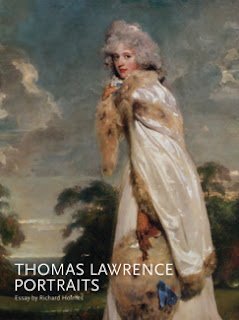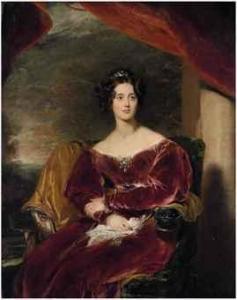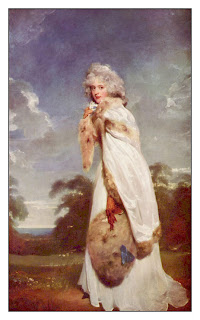 |
| Copyright The Art of Mourning |
Although the craze for Lover’s Eyes – and it was a craze, thanks to the Prince Regent, later King George IV, who was said to have exchanged lovers’ eyes with his putative wife, Maria Fitzherbert and perhaps with his lover, Mary Robinson (the actress known as Perdita) – flourished for only a short time, his niece Queen Victoria years later was also said to be fond of them and gave them as gifts. To quote Candice Hern, a fellow writer of historical romance novels, “even though the notion of eye brooches was by that time very old-fashioned.”
Ah, but in their day…! Christopher Stocks, writing in the Patek Philippe Magazine last year, noted:
“The combination of royalty and society was as potent then as it is today, and before long the fashion for eye miniatures spread through European high society and as far as Russia and the U.S.”
I first became aware of eye miniatures when I sat in on a presentation given by Candice Hern, as a matter of fact. This was some years ago at a Romance Writers of America conference. Candice’s very fine website shows the eyes in her collection:
 |
| Copyright Candice Hern |
The examples displayed are prime, and are indeed lovely. Hers are all set into brooches; two show blue-eyed women; two are brown-eyed men. Who they are, again, is not known, and neither are the artists who painted them nor for whom they were intended, though we do have clues that several – and maybe a lot more than several – were painted by the prolific and noted miniaturists Richard Cosway and George Engleheart. (Ozias Humphry is said to have painted a few, also.)
Though a number of miniatures bearing the signature of Cosway are suspected not to be his, Engleheart did make a practice in his later years of initialing or signing his name to his work and these are considered genuine, not fakes. (These jottings are not easy to see unless the eye miniature is removed from its setting.)
Speaking of fakes, they are, alas, proliferating in this age of photo-shopping and cropping and Internet image borrowing. They can, however, be distinguished easily from the real thing upon close inspection owing to the presence of pixels rather than brushstrokes. See this very good article by the late Barry Weber, an expert in the field who often appeared on PBS’s Antiques Road Show.
Weber went on to say that “murky colors that use dark sepia tones” should make one wary, as these colors may be “a heavy-handed effort to falsify age.” He also cautioned, “an antique frame doesn’t add authenticity to the painting.” Camilla Lombardi, director of the portrait miniatures department at Bonham’s in London has been seeing an increasing number of fakes as the real thing becomes rarer, particularly noting caution if a nose, or part of a nose, appears in an eye miniature. She says that in genuine eye miniatures there should be “no real sign of the nose where you would expect it, whereas in a cut-down eye miniature you would see the line of the nose and shadow where the corner of the eye meets the bridge of the nose.”
 |
| Copyright PBS |
What George Williamson had to say in The Art of the Miniature Painter about the care of miniature portraits would apply as well to the much tinier lover’s eyes:
“Miniatures should not be exposed to a strong light… Violent changes of temperature are to be avoided, and should the ivory become too dry it may crack… Lockets and pendants containing miniatures should not be worn at dances, or on any occasion where the wearer is liable to become overheated, as acid condensation takes place inside the glass which may ruin the painting.”
Ather problem – which perhaps accounts for the rarity of eye miniatures set into rings rather than brooches, pendants, or cases – is that water could get under the glass protecting the miniature and wash away the watercolors. Washing hands was death to a lover’s eye set into a ring.
 |
| Copyright parisatelier.blogspot.com |
And what are these eye miniatures, these oh-so-romantic lover’s eyes, worth in today’s antique jewelry market? Barry Weber noted, “Few pieces cost less than $1,000.” He added, “American pieces are spectacularly rare,” mentioning “one jewel-encrusted example worth $20,000.” Christopher Stocks values unattributed pieces at $1,500, whilst attributed pieces could go as high as $7,500 each. In the 1950s, when no one wanted them, they could be gotten for next to nothing, out of favor and even considered “repulsive” – to quote the art critic David Piper in 1957 — as both jewelry and art.
The oft-cited reference – in Charles Dickens’ 1848 novel, Dombey and Son – reinforces Piper’s condemnation, with the dismissive description of the lover’s eye worn by the elderly spinster Miss Tox as “representing a fishy old eye…” How anyone could see these eyes in that way is just another example of how one person’s treasure can be considered another person’s trash, or, de gustibus non disputandum est.
Lover’s eyes are exquisite, in the opinion of many contemporary collectors, connoisseurs, and lovers of beautiful objects, and this exhibition will bring them to the forefront once again. It has only taken some 200 years! And, reader, do go through Great-Grandmother’s box of trinkets in the attic once more, for who knows what precious eyes may be lurking there, desperate for the light.
A 20th-century version of an eye miniature, from a Bronzino portrait; note the differences between this and a classic lover’s eye.




























